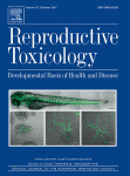A Human Induced Pluripotent Stem Cell-Based In Vitro Assay Predicts Developmental Toxicity Through a Retinoic Acid Receptor-Mediated Pathway for a Series of Related Retinoid Analogues [Reproductive Toxicology, October 2017]
Jessica A. Palmer, Alan M. Smith, Laura A. Egnash, Michael R. Colwell, Elizabeth L.R. Donley, Fred R. Kirchner, Robert E. Burrier
Abstract
 The relative developmental toxicity potency of a series of retinoid analogues was evaluated using a human induced pluripotent stem (iPS) cell assay that measures changes in the biomarkers ornithine and cystine. Analogue potency was predicted, based on the assay endpoint of the ornithine / cystine (O/C) ratio, to be all-trans-retinoic acid > TTNPB > 13-cis-retinoic acid (approximately equal to) 9-cis-retinoic acid > acitretin > etretinate > retinol. These rankings correlate with in vivo data and demonstrate successful application of the assay to rank a series of related toxic and non-toxic compounds. The retinoic acid receptor alpha (RARalpha)-selective antagonist Ro 41–5253 inhibited the cystine perturbation caused by all-trans-retinoic acid, TTNPB, 13-cis-retinoic acid, 9-cis-retinoic acid, and acitretin. Ornithine was altered independent of RARalpha in all retinoids except acitretin. These results suggest a role for an RARalpha-mediated mechanism in retinoid-induced developmental toxicity through altered cystine metabolism.
The relative developmental toxicity potency of a series of retinoid analogues was evaluated using a human induced pluripotent stem (iPS) cell assay that measures changes in the biomarkers ornithine and cystine. Analogue potency was predicted, based on the assay endpoint of the ornithine / cystine (O/C) ratio, to be all-trans-retinoic acid > TTNPB > 13-cis-retinoic acid (approximately equal to) 9-cis-retinoic acid > acitretin > etretinate > retinol. These rankings correlate with in vivo data and demonstrate successful application of the assay to rank a series of related toxic and non-toxic compounds. The retinoic acid receptor alpha (RARalpha)-selective antagonist Ro 41–5253 inhibited the cystine perturbation caused by all-trans-retinoic acid, TTNPB, 13-cis-retinoic acid, 9-cis-retinoic acid, and acitretin. Ornithine was altered independent of RARalpha in all retinoids except acitretin. These results suggest a role for an RARalpha-mediated mechanism in retinoid-induced developmental toxicity through altered cystine metabolism.


